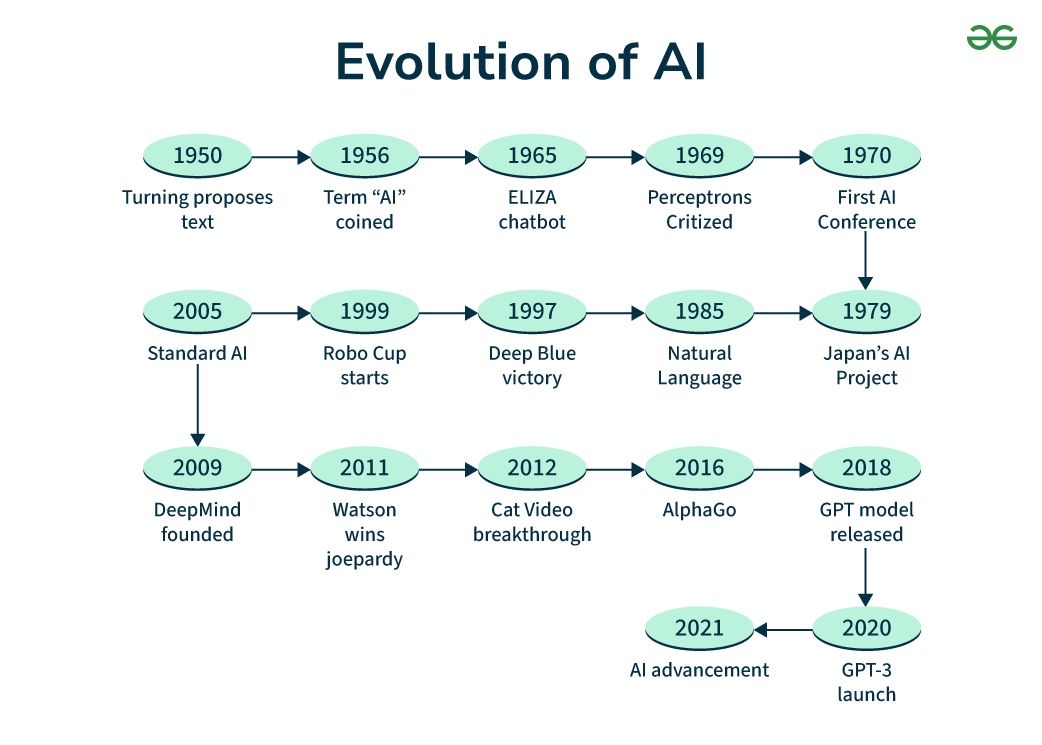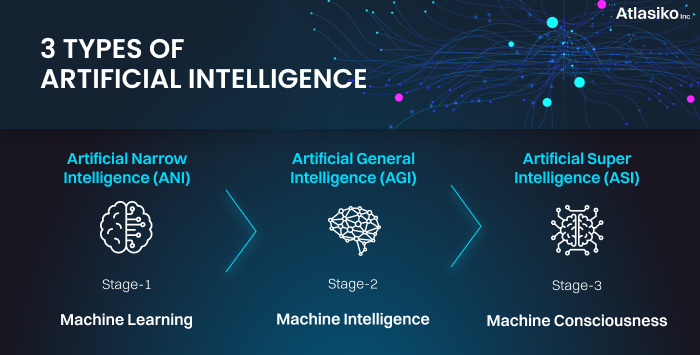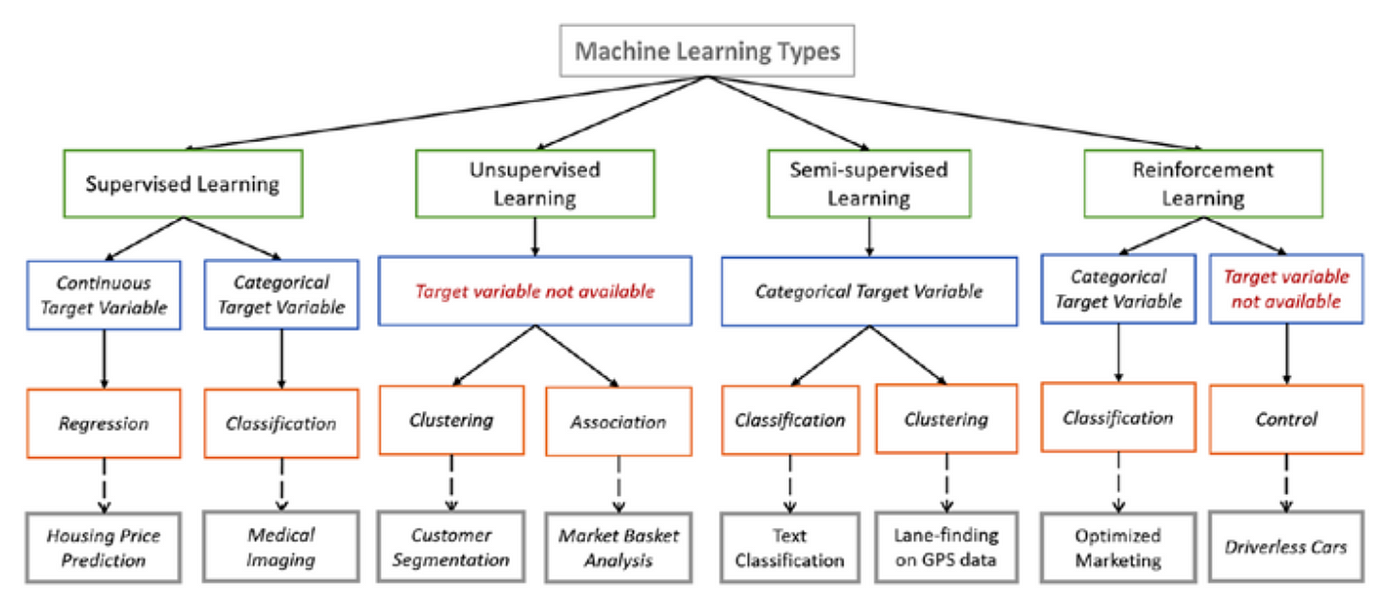
What is AI and ML
Artificial Intelligence (AI) refers to the simulation of human intelligence in machines that are designed to think, learn, and problem-solve like humans. AI systems can perform tasks that typically require human intelligence, such as visual perception, speech recognition, decision-making, language translation, and more. Machine Learning (ML) is a subset of AI that focuses on the development of algorithms that allow computers to learn from and make decisions based on data. Instead of being explicitly programmed to perform a task, ML algorithms use statistical techniques to identify patterns in data, learn from those patterns, and make predictions or decisions without human intervention.
History and Evolution of AI and ML
The journey of Artificial Intelligence (AI) and Machine Learning (ML) spans several decades and has evolved through various phases:
1. Early Beginnings (1950s-1960s):
* 1950: Alan Turing introduces the "Turing Test" to assess machine
intelligence.
* 1956: The term "Artificial Intelligence" is coined at the
Dartmouth Conference.
* 1957: Frank Rosenblatt develops the Perceptron, an early neural
network model.
2. The Rise of Expert Systems (1970s-1980s):
* 1970s: AI research progresses with logic-based systems and expert
systems.
* 1980s: Machine Learning gains traction, but the "AI Winter" sets
in due to limited computing power and funding.
3. Resurgence and Deep Learning (1990s-2000s):
* 1990s: AI resurfaces with advancements in probabilistic reasoning
and ML algorithms.
* 1997: IBM's Deep Blue defeats chess champion Garry Kasparov.
* 2000s: AI evolves with improved computing power, paving the way
for natural language processing and computer vision.
4. Modern AI and Deep Learning (2010s-Present):
* 2010s: Deep learning revolutionizes image and speech recognition,
with companies investing heavily in AI.
* 2012: AlexNet wins ImageNet, showcasing the power of CNNs.
* 2016: AlphaGo beats world Go champion Lee Sedol.
* 2020s: AI dominates industries like healthcare, autonomous
vehicles, and natural language processing, with advanced ML techniques
like reinforcement learning and generative models.

Types of AI
AI can be categorized into three main types based on its capabilities
1. Narrow AI (Weak AI):
* Definition: AI systems that are designed to perform a specific
task or a narrow range of tasks. They are highly specialized and operate
under a limited context.
* Examples: Virtual assistants like Siri and Alexa, recommendation
systems on Netflix, image recognition systems, etc.
* Applications: Specific tasks like speech recognition, image
classification, recommendation systems, and autonomous driving.
2. General AI (Strong AI):
* Definition: AI systems that possess the ability to understand,
learn, and apply intelligence across a wide range of tasks, similar to
human cognitive abilities.
* Examples: As of now, General AI does not exist; it is a theoretical
concept.
* Applications: If achieved, General AI would be capable of performing any
intellectual task that a human can do.
3. Superintelligent AI:
*Definition: A form of AI that surpasses human intelligence and
capability in virtually every field, including creativity,
problem-solving, and emotional intelligence.
* Examples: This is a hypothetical concept and does not currently exist.
* Applications: Superintelligent AI could revolutionize fields like
medicine, science, and technology, but it also raises significant ethical
and existential concerns.

Types of Machine Learning
ML can be broadly classified into four types:
1. Supervised Learning:
* Definition: Involves training an algorithm on a labeled dataset,
where the correct output is known. The model learns by comparing its
output with the correct answers and adjusting accordingly.
*
Examples: Spam detection in email, sentiment analysis, predictive
analytics.
* Algorithms: Linear regression, logistic regression,
decision trees, support vector machines (SVM), neural networks.
2. Unsupervised Learning:
* Definition: Involves training an algorithm on an unlabeled
dataset, where the output is unknown. The model tries to find hidden
patterns or intrinsic structures within the data.
* Examples: Market basket analysis, customer segmentation, anomaly
detection.
* Algorithms: K-means clustering, hierarchical clustering, principal
component analysis (PCA), autoencoders.
3. Semi-Supervised Learning:
Definition: A combination of supervised and unsupervised learning.
The model is trained on a small amount of labeled data and a large amount
of unlabeled data.
*Examples: Image recognition tasks where only some images are labeled.
*Algorithms: Semi-supervised support vector machines, transductive SVM,
generative models.
4. Reinforcement Learning:
* Definition: Involves training an agent to make a sequence of
decisions by rewarding or punishing it based on its actions. The goal is
to maximize cumulative rewards.
*Examples: Robotics, gaming (like AlphaGo), autonomous vehicles.
*Algorithms: Q-learning, deep Q-networks (DQN), policy gradients, deep
deterministic policy gradient (DDPG).

Why AI and ML?
1. Automation of Repetitive Tasks: AI and ML can automate mundane and repetitive tasks, freeing up human resources for more creative and complex work.
2. Data-Driven Decision Making: With the ability to analyze vast amounts of data quickly and accurately, AI and ML enable better decision-making in business, healthcare, finance, and more.
3. Personalization: AI and ML enable personalized experiences in various domains, from e-commerce to entertainment, by analyzing user behavior and preferences.
4. Improving Efficiency: AI systems can optimize processes in industries such as manufacturing, logistics, and supply chain, leading to reduced costs and improved efficiency.
5. Innovation in Healthcare: AI and ML are driving innovation in healthcare by improving diagnostics, drug discovery, personalized medicine, and patient care.
6. Economic Growth: AI and ML have the potential to contribute significantly to economic growth by creating new industries, improving productivity, and fostering innovation.
How to Learn AI and ML?
1. Understand the Basics:
* Start by understanding the basic concepts of AI, ML, and data science.
* Learn about different types of AI and ML, and the various algorithms and
techniques used in the field.
2. Learn Programming:
* Proficiency in programming languages like Python, R, or Java is
essential.
* Python is the most commonly used language in AI and ML
due to its simplicity and the vast number of libraries available.
3. Mathematics and Statistics:
* A strong foundation in mathematics, particularly in linear algebra,
calculus, probability, and statistics, is crucial for understanding ML
algorithms.
* Topics like matrices, derivatives, integrals,
probability distributions, and hypothesis testing are particularly
important.
4. Learn Key Libraries and Tools:
* Familiarize yourself with popular ML libraries and frameworks like
TensorFlow, PyTorch, Scikit-Learn, Keras, and Pandas.
* Learn how to use tools like Jupyter Notebook, Anaconda, and Git for
version control.
5. Study ML Algorithms:
* Learn about various ML algorithms such as linear regression, decision
trees, k-nearest neighbors (KNN), support vector machines (SVM), and
neural networks.
* Understand how these algorithms work, their applications, and how to
implement them.
6. Work on Projects:
* Apply your knowledge by working on real-world projects. Start with
simple projects like sentiment analysis, image classification, or a
recommendation system.
* Participate in Kaggle competitions to practice your skills and learn
from other practitioners.
7. Learn About Data:
* Understanding data is critical in ML. Learn about data preprocessing,
cleaning, and exploration.
* Familiarize yourself with concepts like
data wrangling, feature engineering, and dimensionality reduction.
8. Deep Learning:
* Once you have a good grasp of ML, delve into deep learning, a subfield
of ML that deals with neural networks with multiple layers (deep neural
networks).
* Study topics like convolutional neural networks (CNNs), recurrent neural
networks (RNNs), generative adversarial networks (GANs), and reinforcement
learning.
9. AI Ethics and Bias:
* Learn about the ethical considerations in AI, including bias in AI models, data privacy, and the societal impact of AI technologies.
10. Stay Updated:
* The field of AI and ML is rapidly evolving. Keep yourself updated by following research papers, attending conferences, and joining AI/ML communities.

What to Learn in AI and ML?
1. Programming Languages:
* Python: The most popular language for AI/ML.
* R: Useful for statistical analysis.
* Java/C++: Used in large-scale AI systems.
2. Mathematics:
* Linear Algebra: Matrices, vectors, eigenvalues, and eigenvectors.
* Calculus: Differentiation, integration, and gradient descent.
* Probability and Statistics: Probability distributions, Bayes'
theorem, hypothesis testing.
* Optimization: Convex optimization, optimization algorithms.
3. Machine Learning Algorithms:
* Supervised Learning: Linear regression, logistic regression,
decision trees, random forests, support vector machines.
* Unsupervised Learning: K-means clustering, hierarchical
clustering, principal component analysis (PCA).
* Reinforcement Learning: Q-learning, deep Q-networks (DQN), policy
gradients.
4. Deep Learning:
* Neural Networks: Basics of neural networks, activation functions,
backpropagation.
* Convolutional Neural Networks (CNNs): Used
in image recognition and computer vision.
*
Recurrent Neural Networks (RNNs): Used in natural language
processing and time series analysis.
* Generative Models:
GANs, variational autoencoders (VAEs).
5. Data Preprocessing and Feature Engineering:
* Data Cleaning: Handling missing data, outlier detection, and data
normalization.
* Feature Engineering: Creating new features,
feature selection, and dimensionality reduction techniques like PCA and
t-SNE.
6. Model Evaluation and Tuning:
* Cross-Validation: Techniques like k-fold cross-validation.
* Hyperparameter Tuning: Grid search, random search, Bayesian
optimization.
* Model Evaluation Metrics: Accuracy,
precision, recall, F1-score, ROC-AUC.
7. AI Ethics and Responsible AI:
* Bias in AI: Understanding and mitigating bias in AI models.
* Data Privacy: Ensuring data privacy and security in AI
applications.
* Explainable AI: Techniques for making AI
models interpretable.
8. Tools and Frameworks:
* TensorFlow and PyTorch: Deep learning frameworks.
*
Scikit-Learn: A machine learning library for Python.
* Keras: High-level
neural networks API.
* Pandas and NumPy: Libraries for data
manipulation and analysis.
9. Big Data Technologies:
* Hadoop and Spark: Frameworks for processing large datasets.
* SQL and NoSQL: Database management systems.
*
Data Warehousing: Techniques for storing and managing large datasets.
10. Specialized Areas:
* Natural Language Processing (NLP): Techniques for processing and
analyzing human language.
* Computer Vision: Techniques for
analyzing and understanding visual data.
* Robotics:
Application of AI in robotics for autonomous systems.
Roadmaps for AI/ML Learning
1. Beginner Level:
* Duration: 3-6 months.
* Focus: Basics of
programming, introduction to AI/ML, basic ML algorithms, small projects.
* Resources: Online courses (Coursera, Udemy), tutorials,
YouTube videos.
2. Intermediate Level:
* Duration: 6-12 months.
* Focus: Advanced ML
algorithms, deep learning, mathematics for ML, larger projects.
*
Resources: Books (e.g., "Hands-On Machine Learning with Scikit-Learn, Keras, and
TensorFlow"), research papers, intermediate courses.
3. Advanced Level:
* Duration: 12-24 months.
* Focus: Specializations
(NLP, computer vision, reinforcement learning), research, contributing to
open-source projects, advanced mathematics.
* Resources:
Research papers, advanced courses, specialized certifications.
4. Expert Level:
* Duration: 2+ years.
* Focus: Cutting-edge research,
developing new algorithms, AI ethics, leading projects, innovation.
* Resources: PhD programs, conferences, journals,
collaboration with industry experts.
Ethical Concerns and Challenges in AI
1. Bias and Fairness:
* Problem: AI systems can inherit biases from training data,
leading to unfair or discriminatory decisions, especially in sensitive
areas like hiring and criminal justice.
* Examples: Facial
recognition systems showing higher error rates for people of color; biased
hiring algorithms.
* Solution: Development of fairness
metrics and techniques to identify and mitigate biases in AI systems.
2. Privacy Concerns:
* Problem: AI systems may infringe on privacy by collecting,
analyzing, and exploiting personal data without adequate consent.
*
Examples: Targeted advertising, surveillance systems, and data
breaches.
* Solution: Implement stronger privacy protection
laws (e.g., GDPR) and develop privacy-preserving techniques such as
federated learning.
3. Job Displacement:
* Problem: Automation driven by AI and robotics is predicted to
replace many jobs, especially those involving routine tasks, leading to
economic disruption.
* Examples: Autonomous vehicles
replacing truck drivers; AI-powered customer service chatbots replacing
human staff.
* Solution: Encourage reskilling programs,
universal basic income (UBI) proposals, and development of new job sectors
that leverage human creativity and social intelligence.
4. Accountability and Transparency:
* Problem: AI systems, particularly deep learning models, can act
as "black boxes," making it difficult to understand how decisions are
made.
* Examples: Lack of transparency in medical diagnostics
or autonomous driving decisions.
* Solution: Focus on
explainable AI (XAI) to design interpretable models and create regulatory
frameworks ensuring accountability.
5. AI in Warfare and Autonomous Weapons:
* Problem: The use of AI in military applications raises ethical
concerns about unintended escalations and lack of human oversight in
lethal decision-making.
* Examples: Autonomous drones and
weapons systems making life-and-death decisions without human
intervention.
* Solution: Calls for international treaties to
regulate or ban the development and use of autonomous weapons.
6. Ethical Use in Healthcare:
* Problem: AI applications in healthcare pose challenges in
balancing innovation with patient privacy, data security, and ensuring
that AI recommendations are medically sound and ethical.
*
Examples: AI used for predictive diagnostics or treatment
recommendations may give incorrect advice or breach patient
confidentiality.
* Solution: Regulatory bodies are
increasingly focusing on AI in healthcare, with an emphasis on
human-in-the-loop systems to validate AI-driven insights.

Conclusion
Learning AI and ML is a journey that requires dedication, continuous learning, and hands-on experience. Start with the basics, build a strong foundation, and gradually explore more advanced topics as you gain confidence and expertise.
Recommended Resources
Below are some highly recommended resources for learning Artificial Intelligence and Machine Learning:
* GeeksforGeeks (GFG): A popular resource for learning AI and ML, offering tutorials, coding problems, and interview preparation materials. (Website: GeeksforGeeks)
* Coursera - Machine Learning by Andrew Ng: One of the most famous and widely recommended online courses for learning Machine Learning from Stanford University. (Website: Coursera)
* Kaggle: A platform for practicing machine learning by participating in competitions and accessing datasets for hands-on learning. (Website: Kaggle)
* fast.ai: Offers free deep learning courses and tutorials that are accessible for beginners with practical implementation using PyTorch. (Website: fast.ai)
* DeepLearning.AI: Provides a specialization in deep learning taught by Andrew Ng, covering neural networks, CNNs, RNNs, and more. (Website: DeepLearning.AI)
* 3Blue1Brown - Neural Networks: A YouTube channel that offers visual and intuitive explanations of AI concepts like neural networks. (Website: YouTube)
* TensorFlow Documentation: Official documentation and tutorials for Google's TensorFlow framework, which is widely used for AI and ML projects. (Website: TensorFlow)
* PyTorch Documentation: The official guide and tutorials for using PyTorch, a popular machine learning library. (Website: PyTorch)